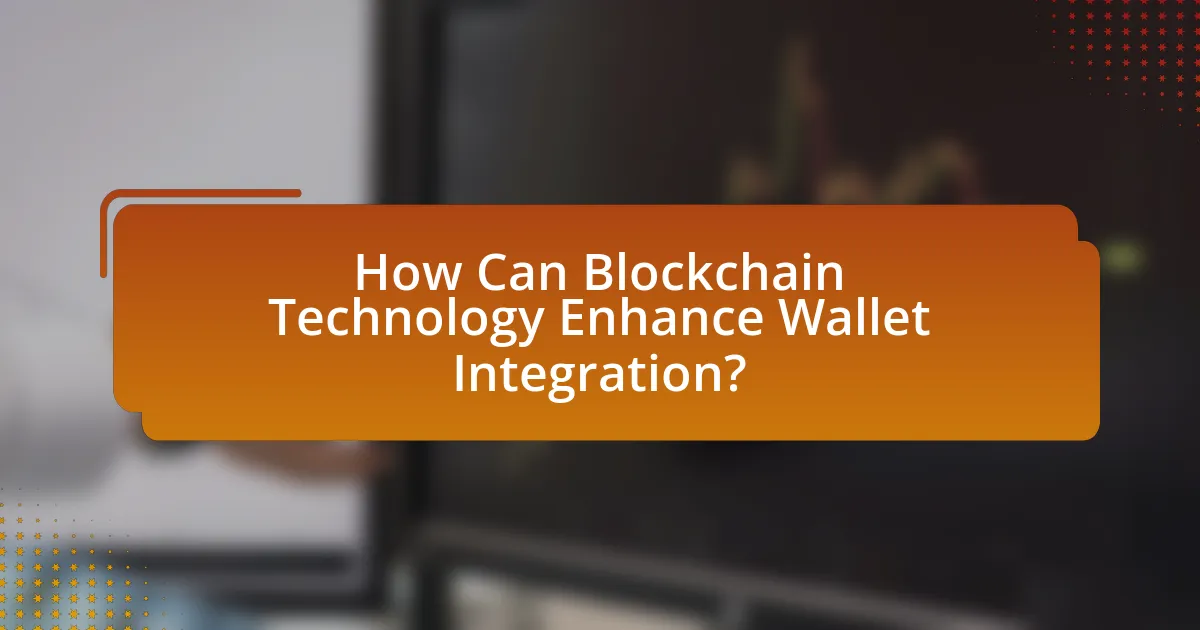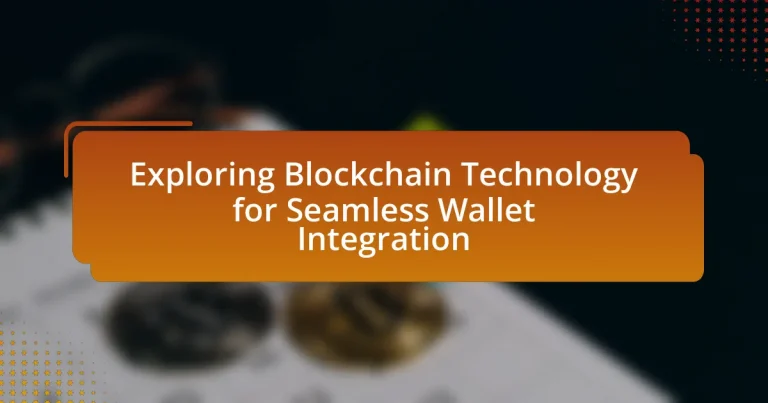Blockchain technology serves as a decentralized digital ledger that enhances wallet integration by ensuring secure and transparent transaction management for cryptocurrencies and digital assets. This article explores the functionality of blockchain, its key components, and the impact of decentralization on wallet integration. It examines various types of wallets, including hot and cold wallets, and discusses the differences between custodial and non-custodial wallets. Additionally, the article addresses challenges in wallet integration, such as security concerns and scalability issues, while highlighting the benefits of blockchain technology in improving transaction speed, efficiency, and user experience. Future trends in wallet integration, including enhanced interoperability and the adoption of decentralized finance functionalities, are also analyzed, along with best practices for ensuring security and user trust in blockchain wallets.

What is Blockchain Technology and How Does it Relate to Wallet Integration?
Blockchain technology is a decentralized digital ledger that records transactions across multiple computers in a way that ensures the security and transparency of data. This technology is fundamental to wallet integration because it allows digital wallets to securely store and manage cryptocurrencies and other digital assets by leveraging the immutable and transparent nature of blockchain. For instance, when a user initiates a transaction through a digital wallet, the transaction is recorded on the blockchain, ensuring that it is verifiable and tamper-proof. This integration enhances user trust and facilitates seamless transactions, as evidenced by the widespread adoption of blockchain in various financial applications, including Bitcoin and Ethereum wallets.
How does blockchain technology function?
Blockchain technology functions as a decentralized digital ledger that records transactions across multiple computers in a way that ensures the security and integrity of the data. Each transaction is grouped into a block, which is then linked to the previous block, forming a chain. This structure prevents alteration of any single block without changing all subsequent blocks, thereby enhancing security. The consensus mechanism, such as Proof of Work or Proof of Stake, validates transactions and maintains the integrity of the blockchain. According to a 2021 report by the World Economic Forum, blockchain technology can reduce fraud and increase transparency in various sectors, demonstrating its effectiveness in maintaining secure and reliable records.
What are the key components of blockchain technology?
The key components of blockchain technology are decentralization, transparency, security, consensus mechanisms, and smart contracts. Decentralization ensures that no single entity controls the entire network, which enhances resilience against failures and attacks. Transparency allows all participants to view transaction history, fostering trust among users. Security is achieved through cryptographic techniques that protect data integrity and prevent unauthorized access. Consensus mechanisms, such as Proof of Work and Proof of Stake, enable agreement among network participants on the validity of transactions. Smart contracts are self-executing contracts with the terms directly written into code, automating processes and reducing the need for intermediaries. These components collectively enable the functionality and reliability of blockchain systems.
How does decentralization impact wallet integration?
Decentralization enhances wallet integration by enabling greater security, user control, and interoperability across various blockchain networks. This shift from centralized systems to decentralized frameworks allows users to manage their private keys, reducing the risk of hacks associated with centralized storage. Furthermore, decentralized wallets can interact with multiple blockchain protocols, facilitating seamless transactions and exchanges without relying on a single point of failure. For instance, decentralized finance (DeFi) platforms leverage this integration to allow users to access a wide range of financial services directly from their wallets, promoting a more inclusive financial ecosystem.
What types of wallets are used in blockchain technology?
There are several types of wallets used in blockchain technology, including hot wallets, cold wallets, hardware wallets, software wallets, and paper wallets. Hot wallets are connected to the internet and allow for quick access to funds, making them suitable for frequent transactions. Cold wallets, on the other hand, are offline and provide enhanced security for long-term storage of cryptocurrencies. Hardware wallets are physical devices that securely store private keys, while software wallets are applications that can be installed on computers or mobile devices. Paper wallets involve printing out the private and public keys on paper, providing a physical form of storage. Each type of wallet serves different needs based on security, accessibility, and user preference.
What are the differences between hot wallets and cold wallets?
Hot wallets are online cryptocurrency wallets that are connected to the internet, allowing for quick and easy access to funds, while cold wallets are offline storage solutions that provide enhanced security by keeping private keys disconnected from the internet. The primary difference lies in their connectivity; hot wallets facilitate immediate transactions but are more vulnerable to hacking, whereas cold wallets, such as hardware wallets or paper wallets, offer greater protection against cyber threats but require more effort to access and use. This distinction is crucial for users to consider based on their needs for convenience versus security in managing digital assets.
How do custodial wallets differ from non-custodial wallets?
Custodial wallets differ from non-custodial wallets primarily in the control of private keys. In custodial wallets, a third party manages the private keys on behalf of the user, meaning the user must trust this entity to secure their funds. Conversely, non-custodial wallets allow users to retain full control over their private keys, providing greater autonomy and security, as users are responsible for their own funds. This distinction is crucial; for instance, a 2021 survey by the Cambridge Centre for Alternative Finance indicated that 75% of cryptocurrency users preferred non-custodial solutions for enhanced security and control.
What challenges exist in integrating wallets with blockchain technology?
Integrating wallets with blockchain technology faces several challenges, including security vulnerabilities, user experience issues, and regulatory compliance. Security vulnerabilities arise from the potential for hacking and fraud, as wallets store sensitive private keys that can be exploited. User experience issues stem from the complexity of blockchain technology, which can deter non-technical users from effectively utilizing wallets. Regulatory compliance presents challenges due to varying laws across jurisdictions, which can complicate the development and operation of wallet services. These challenges must be addressed to ensure secure, user-friendly, and compliant wallet integration with blockchain technology.
How do security concerns affect wallet integration?
Security concerns significantly impact wallet integration by necessitating robust encryption and authentication measures to protect user data and assets. Wallet providers must implement advanced security protocols, such as multi-factor authentication and end-to-end encryption, to mitigate risks of hacking and fraud. According to a report by Cybersecurity Ventures, cybercrime is projected to cost the world $10.5 trillion annually by 2025, highlighting the critical need for secure wallet solutions. Additionally, regulatory compliance, such as adhering to the General Data Protection Regulation (GDPR), further influences wallet integration processes, as providers must ensure user privacy and data protection. These security measures not only enhance user trust but also facilitate broader adoption of digital wallets in the blockchain ecosystem.
What are the scalability issues related to wallet integration?
Scalability issues related to wallet integration primarily involve transaction throughput, latency, and network congestion. As the number of users and transactions increases, existing blockchain networks may struggle to process transactions efficiently, leading to slower confirmation times and higher fees. For instance, Bitcoin’s network can handle approximately 7 transactions per second, while Ethereum processes around 30, which can become bottlenecks during peak usage periods. These limitations can hinder user experience and adoption, as users may face delays and increased costs when using wallets integrated with such networks.

How Can Blockchain Technology Enhance Wallet Integration?
Blockchain technology can enhance wallet integration by providing secure, transparent, and efficient transaction processing. The decentralized nature of blockchain eliminates the need for intermediaries, reducing transaction costs and time. Additionally, blockchain’s cryptographic security ensures that user data and transaction details are protected from unauthorized access, fostering trust among users. For instance, a study by the Cambridge Centre for Alternative Finance indicates that blockchain can facilitate faster cross-border payments, which is crucial for wallet services aiming to operate globally. This integration not only improves user experience but also expands the functionality of digital wallets, allowing for features like multi-currency support and real-time transaction tracking.
What benefits does blockchain technology provide for wallet integration?
Blockchain technology enhances wallet integration by providing increased security, transparency, and efficiency. The decentralized nature of blockchain ensures that transactions are immutable and tamper-proof, significantly reducing the risk of fraud. Additionally, blockchain enables real-time transaction verification, which streamlines the process and minimizes delays. According to a report by Deloitte, blockchain can reduce transaction costs by up to 40% due to its ability to eliminate intermediaries. This combination of security, transparency, and cost-effectiveness makes blockchain an ideal solution for wallet integration.
How does blockchain improve transaction speed and efficiency?
Blockchain improves transaction speed and efficiency by enabling direct peer-to-peer transactions without intermediaries. This eliminates the delays associated with traditional banking systems, which often require multiple verification steps and processing times that can take days. For instance, blockchain transactions can be completed in minutes or even seconds, depending on the network’s congestion and the specific blockchain protocol used. Additionally, the use of smart contracts automates processes and reduces the need for manual intervention, further enhancing efficiency. According to a study by the World Economic Forum, blockchain technology has the potential to reduce transaction costs by up to 90%, demonstrating its significant impact on both speed and efficiency in financial transactions.
What role does transparency play in wallet integration?
Transparency is crucial in wallet integration as it fosters trust among users by ensuring that transactions are visible and verifiable on the blockchain. This visibility allows users to track their transactions in real-time, reducing the risk of fraud and enhancing security. For instance, blockchain’s immutable ledger provides a permanent record of all transactions, which can be audited and verified by any participant in the network. This level of transparency not only builds user confidence but also encourages wider adoption of digital wallets, as users feel more secure knowing that their financial activities are transparent and accountable.
How can user experience be optimized in wallet integration?
User experience in wallet integration can be optimized by ensuring a seamless, intuitive interface that minimizes user friction. Simplifying the onboarding process, such as using single sign-on options and clear instructions, enhances user engagement. Additionally, incorporating features like transaction history, real-time notifications, and easy access to customer support can significantly improve user satisfaction. Research indicates that 70% of users abandon apps due to poor usability, highlighting the importance of a user-centric design approach in wallet integration.
What features enhance usability in blockchain wallets?
User-friendly interfaces enhance usability in blockchain wallets. Intuitive design allows users to navigate easily, while features like multi-language support cater to a global audience. Additionally, seamless integration with various cryptocurrencies and tokens simplifies transactions. Security features, such as two-factor authentication and biometric access, build user trust. Furthermore, transaction history and balance tracking provide transparency, enabling users to manage their assets effectively. These features collectively contribute to a more accessible and efficient user experience in blockchain wallets.
How can wallet interfaces be designed for better user engagement?
Wallet interfaces can be designed for better user engagement by prioritizing user experience through intuitive navigation, personalized features, and robust security measures. Intuitive navigation simplifies the user journey, allowing users to easily access key functionalities such as transactions, balance checks, and settings. Personalized features, such as customizable dashboards and transaction alerts, enhance user interaction by catering to individual preferences. Additionally, robust security measures, including biometric authentication and two-factor authentication, build user trust and encourage frequent use. Research indicates that user-friendly interfaces can increase engagement rates by up to 50%, demonstrating the importance of design in fostering user interaction with wallet applications.

What Future Trends Can We Expect in Blockchain Wallet Integration?
Future trends in blockchain wallet integration include enhanced interoperability, increased security measures, and the adoption of decentralized finance (DeFi) functionalities. Enhanced interoperability will allow different blockchain networks to communicate seamlessly, enabling users to manage multiple cryptocurrencies within a single wallet. Increased security measures, such as biometric authentication and multi-signature capabilities, will protect users from hacks and unauthorized access, as evidenced by the rise in security breaches in the crypto space. The integration of DeFi functionalities will enable users to access lending, borrowing, and yield farming directly from their wallets, reflecting the growing trend of decentralized financial services. These trends are supported by the increasing demand for user-friendly and secure digital asset management solutions.
How is the adoption of blockchain wallets evolving?
The adoption of blockchain wallets is rapidly increasing, driven by growing interest in cryptocurrencies and decentralized finance. As of 2023, the number of blockchain wallet users has surpassed 100 million globally, reflecting a significant rise from approximately 50 million in 2020. This surge is attributed to enhanced user experience, improved security features, and the integration of wallets into various applications and platforms, making them more accessible to everyday users. Additionally, regulatory clarity in several regions has fostered trust and encouraged more individuals and businesses to adopt blockchain wallets for transactions and asset management.
What industries are leading the way in blockchain wallet integration?
The financial services industry is leading the way in blockchain wallet integration. This sector utilizes blockchain technology to enhance security, streamline transactions, and reduce costs associated with traditional banking methods. According to a report by Deloitte, 40% of financial institutions are actively exploring blockchain solutions, indicating a strong commitment to integrating blockchain wallets for improved customer experiences and operational efficiency. Additionally, the retail industry is also adopting blockchain wallets to facilitate secure payments and enhance customer loyalty programs, further demonstrating the technology’s versatility across different sectors.
How are regulatory changes impacting wallet integration?
Regulatory changes are significantly impacting wallet integration by imposing stricter compliance requirements on digital wallets. These regulations often mandate Know Your Customer (KYC) and Anti-Money Laundering (AML) protocols, which require wallet providers to verify user identities and monitor transactions for suspicious activity. For instance, the Financial Action Task Force (FATF) guidelines have led many jurisdictions to enforce these standards, resulting in increased operational costs and complexity for wallet integration. Consequently, wallet providers must adapt their systems to ensure compliance, which can slow down the integration process and limit the availability of services in certain regions.
What are the best practices for seamless wallet integration?
The best practices for seamless wallet integration include ensuring user-friendly interfaces, implementing robust security measures, and providing comprehensive support for multiple cryptocurrencies. User-friendly interfaces enhance the customer experience, as studies show that 88% of online consumers are less likely to return to a site after a bad experience. Robust security measures, such as two-factor authentication and encryption, are essential, as 43% of cyber attacks target small businesses, highlighting the need for strong protection. Supporting multiple cryptocurrencies increases accessibility and user adoption, as the global cryptocurrency market reached a valuation of over $2 trillion in 2021, indicating a diverse user base.
How can developers ensure security in wallet integration?
Developers can ensure security in wallet integration by implementing robust encryption protocols and adhering to best practices for secure coding. Utilizing end-to-end encryption protects sensitive data during transmission, while secure coding practices, such as input validation and error handling, mitigate vulnerabilities. According to the OWASP Top Ten, which outlines critical security risks, addressing these vulnerabilities can significantly reduce the likelihood of attacks. Additionally, regular security audits and penetration testing help identify and rectify potential weaknesses in the integration process, further enhancing security measures.
What strategies can enhance user trust in blockchain wallets?
To enhance user trust in blockchain wallets, implementing robust security measures is essential. This includes utilizing multi-factor authentication (MFA), which significantly reduces the risk of unauthorized access; studies show that MFA can block 99.9% of automated attacks. Additionally, providing transparent information about wallet security protocols and regular audits can build confidence among users. For instance, wallets that undergo third-party security assessments and publish their findings demonstrate accountability and reliability. Furthermore, offering user-friendly interfaces and responsive customer support can improve user experience, fostering trust through accessibility and assistance.

